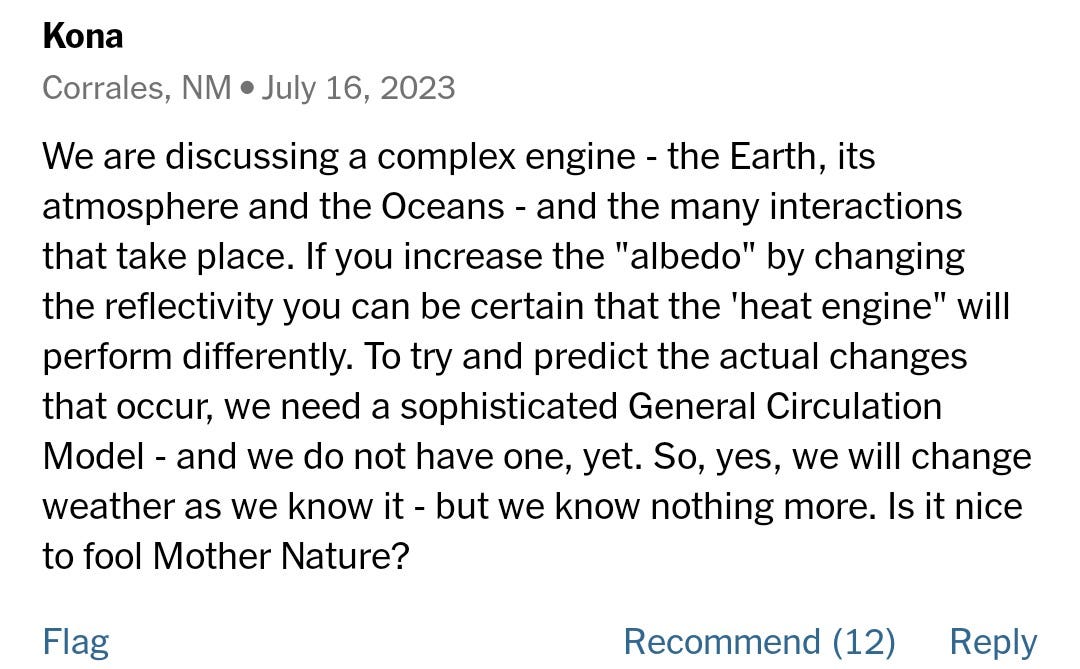Let's Talk About Talking About Geoengineering
A discussion of the conversation around the dialogue

The effects of climate change remind me of those stats that say we all eat five pounds1 of rat poop every year. Call me fancy, but the ideal amount of rat poop I’d like to eat is zero. Unless maybe I’m on a shock jock radio show and they’re daring me to eat rat poop, but even then I only want to eat the minimum amount I need to eat to win Foo Fighters tickets.
Unfortunately, eating no rat poop simply isn’t an option. Similarly, suffering zero effects of climate change is off the table; the effects are already here. I sometimes think it was a mistake for the Paris Agreement to set an explicit goal of keeping global temperatures below two degrees Celsius above pre-industrial levels. I think that made some people think that 1.99 degrees = happy bunnies frolicking beneath gumdrop rainbows, while 2.01 degrees = cannibalistic motorcycle gangs roving a barren hellscape. We’re almost certain to end up somewhere in between those extremes.
The Candyland/apocalypse false binary might be making our already-pretty-moronic climate change dialogue even moronic-erer. Last week, the New York Times ran a feature about sunlight-reflecting white paint developed by professors at Perdue (the university, not the chicken torture company). The paint is really, really white — we’re talking Wilco concert in Maine white. It is functionally the opposite of the artwork for Spinal Tap’s Smell the Glove album, in that it could be none more white.
The paint mitigates climate change in two ways. First, painting a roof with it cools the building, reducing the need for air conditioning. Second, any surface covered with the paint reflects more light than it absorbs, which creates a general cooling effect. In fact, if an area about half the size of the United States2 was covered with the paint, it could halt the rise in global temperatures.
Nobody is proposing that we paint half the United States white. Also, Christo of Christo and Jeanne-Claude passed away in 2020, so there’s no chance of a large-scale art instillation in which they, say, cover Argentina in white-tinged fabric. The calculation is purely theoretical: If you did paint enough roofs, parking lots, and other stuff so that it added up to an area half the size of the US, then the planet would reflect more heat than it absorbs. Which would make the white paint a form of “geoengineering”, which would make it highly controversial, and that’s what I want to talk about.
Geoengineering is the idea that we could mitigate climate change by changing how the Earth processes sunlight.3 It often involves big, super-villain-sounding ideas, like changing the opacity of clouds or placing mirrors in space to reflect sunlight. It’s basically the nexus of the Venn diagram containing Arthur C. Clarke, the Lorax, and Dr. Evil, albeit ostensibly for good. And it has some people understandably nervous.
This Intelligence Squared debate is a good summary of the geoengineering controversy. Basically, the anti-geoengineering side argues that these plans are way too speculative and risky. The pro-geoengineering side — which would more accurately be called the “pro considering geoengineering side” — argues that hell yes, these plans are speculative and risky, but given the scale of the problem, we need to consider them in case they’re needed in the future.
Note that nobody is saying “Geoengineering is simple and awesome, everyone chill out, this is going to be great.” I’m not aware of any serious person who considers geoengineering to be anything other than an emergency backup plan. In terms of risk mitigation, it’s like putting a bunch of mattresses at the bottom of a gorge before you get drunk and walk along the canyon edge: It might work — and then again it might not — but not for nothin’ you should really consider not getting drunk and walking along a cliff to begin with.
Nonetheless, I find it slightly odd that geoengineering doesn’t get more traction with people who are worried about climate change. The case for geoengineering stems from the seriousness of the problem; the argument is less “altering the atmosphere sounds fun” and more “well if we get into a feedback loop then what’s your plan if you’re so goddamned smart?” I attribute geoengineering’s understated place in the dialogue partly to the fact that some percentage of the environmental movement is a cult that sees climate change as an opportunity to scold humanity for its wickedness. But I ignore those people; they’re all presently glued to various artworks around the world anyway, so they’re functionally removed from the dialogue.
More relevant is the fact that many not-insane people are dead set against geoengineering. The subject is controversial enough that the Times felt the need to include the anti-geoengineering argument in their article. They wrote:
Geoengineering — manipulating different processes to control the Earth’s climate — has also been criticized for distracting from the root problem: Humans must stop burning fossil fuels to avoid more catastrophic effects of climate change.
The response to the Times article in the comments section and on Twitter was overwhelmingly positive, but idea that we should focus exclusively on carbon emissions and steer clear of geoengineering was present:
The problem here is false binaries — two of them, in fact. The first is that the effects of climate change will either be minimal or disastrous, and the second is that we’ll either engage in planetary-scale geoengineering projects or none at all.
Environmentalists often talk about the worst-case climate change scenarios because those are the ones that get people’s attention. The mental image of water half-way up the Empire State Building makes more of an impact than an Excel sheet adding up the hidden costs of more frequent natural disasters. And the apocalyptic scenarios aren’t impossible — especially if we say “fuck it” and keep doing what we’re doing — but they’re very unlikely. The scenario that’s extremely likely is that climate change will cause significant disruptions and be a problem for the rest of the century. And in that scenario, we’ll need to decide what mix of carbon reduction/removal and environmental modulation makes sense.
With that being true, geoengineering efforts should also not be thought of in binary terms. There is no big lever on the wall with positions labeled “No geoengineering whatsoever” and “Yes, geoengineering, all of it”. The word “geoengineering” refers to several ideas, plus many more ideas that scientists ain’t thunk up yet, and those ideas range from “possibly genius” to “obviously crackpot”. These ideas are categorically similar, but that says nothing about their quality. Radiohead and Coldplay are categorically similar, but one is the best band of the past 30 years and the other is arguably worse than the “cannibal motorcycle gangs” scenario I described earlier.
Geoengineering, generally, is not all-or-nothing, and neither is any specific geoengineering project. Painting an area equivalent to half of the US might counteract global temperature rises, but painting a smaller area would do something. And that something isn’t nothing. Maybe the best course of action will be to paint stuff until we reach the point of major diminishing returns. Maybe we’ll take the same approach with reforestation: We could plant trees where it makes sense but stop when it ceases to be cost-effective. The same philosophy could be applied to carbon sequestration, ocean fertilization, or microalgae cultivation. There are a lot of things we could do a little, and combined with reductions in our carbon output, a lot of a little might be enough.
It’s easy to fixate on the apocalyptic possibilities of climate change. Humans have long been fascinated by The End Times; they were the subject of oral traditions and religious texts before they were the topic of movies and video games. But just as it’s easy to fixate on the worst-case scenarios with climate change, it’s easy to fixate on the worst-case scenarios with geoengineering. In reality, both the challenge and our response to the challenge are likely to be some nuanced, in-between thing (as most things are). Rational, cost-benefit analysis will be more useful than hysterics. And “geoengineering” shouldn’t be a dirty word, because geoengineering is not all space mirrors and man-made atmospheres; sometimes it’s as simple as a heapin’ helpin’ of bright white paint.
Or something like that — I’m not going to bother find the real number.
The NY Times article doesn’t say “about half the size of the United States”; it says “slightly more than half the size of the Sahara Desert”. I don’t like this comparison; people don’t have a good sense of how big the Sahara is. I googled it and learned that the Sahara is a bit smaller than the United States, so instead of saying “more than half the size of the Sahara”, I said “about half the size of the US”.
If you want to dig into the details — and I don’t — geoengineering can refer to altering how the Earth processes sunlight or to efforts to remove carbon from the atmosphere. For that reason, many people don’t like the term; you sometimes hear people refer to “solar radiation management” and “carbon dioxide removal” as two separate things. I think this delineation makes sense, but “geoengineering” is the word people use, so that’s the word I’m going to use, too. Though, it is true: When I say “geoengineering” in this article, I’m talking about solar radiation management and not carbon dioxide removal.







A problem with resistance to geoengineering is that there effectively isn't a "no geoengineering whatsoever" option either, because the whole point of "anthropogenic climate change" is that we're already doing it and have been doing it about as long as we've been human. (Not just since the Industrial Revolution or even agriculture - ancient humans would burn forests on purpose for reasons like flushing out game, or making more plains and clearings to hunt in.) Humanity has a lasting impact on the planet - this fact is already baked in - and our actual choice is what of that impact is intentional.
For that matter, Mother Nature is not a real person, has even less coordination than humanity, and will sometimes do things that don't contribute to a steady state equilibrium. Remember the ancient human wildfire strategy I mentioned? Several predator bird species do the same thing for the same reasons, if they can grab a burning branch from a lightning strike or something.
Anyway, a problem with comparing things to the size of the USA is that you have to specify the Lower 48, or the inclusion of other territories and Alaska in particular really changes the comparison.
I'd also point out that we basically got into this mess through untinentional geo-engineering by pumping tons of greenhouse gases into the atmosphere, so it's not like we haven't already been doing this. Now, that doesn't exactly make the case against unintended consequences, but reversing one form of geo-engineering with another doesn't sound quite as crazy. Especially if we take an incremental, conservative approach aimed at taking the edge off of climate change and buying time, rather than seeing this as a long-term solution. Ofc, that's going to be the temptation.